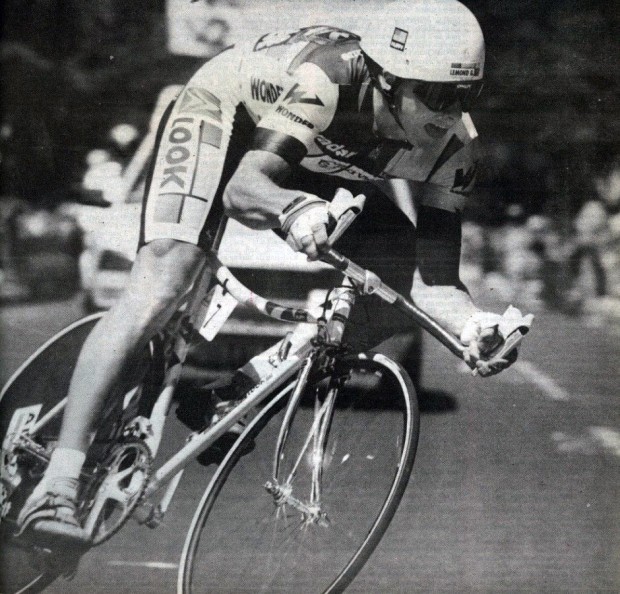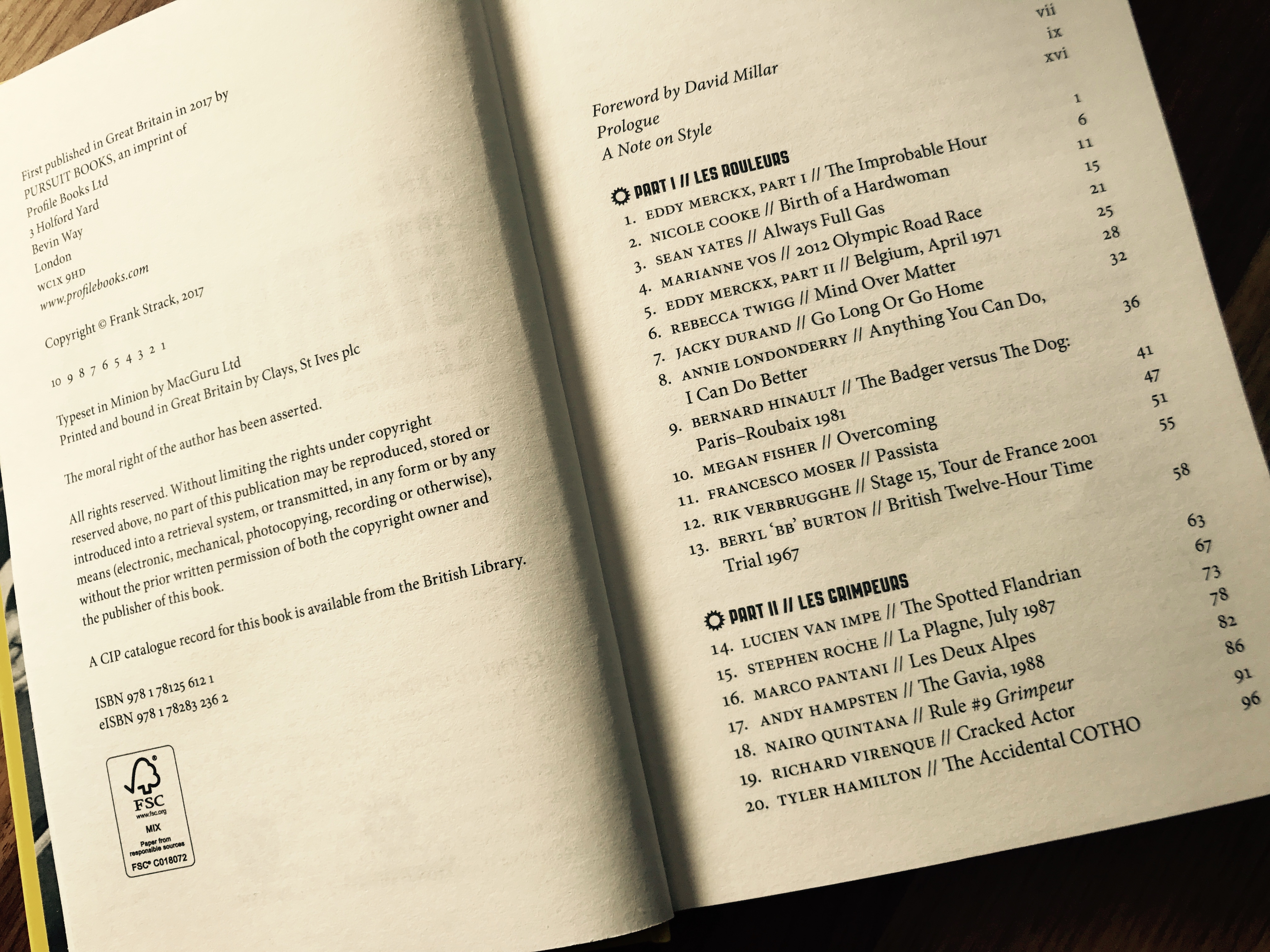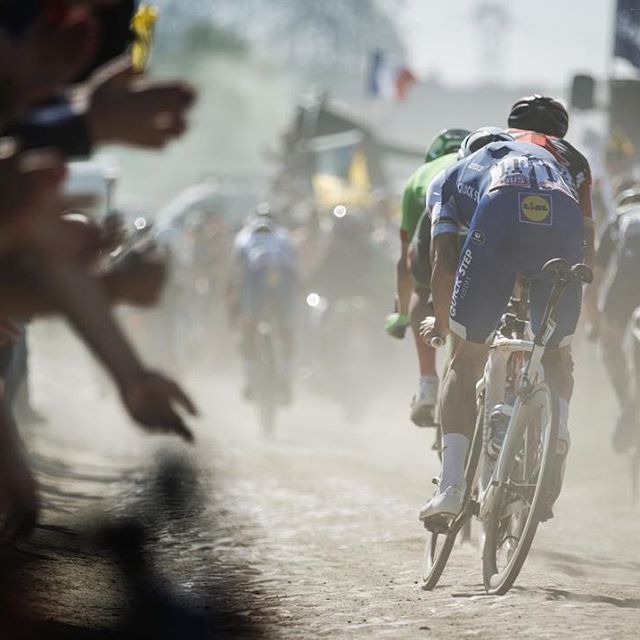LeMaster of the V-Locus

Finding The V-Locus is something of an extension of the Goldilocks Principle; bars set somewhere between Sit Up and Beg and a face-plant, saddle height somewhere between speed skater and Baryshnikov, and reach somewhere between a unicycle and the Batpod. This is art more than it is science, a process of iteration and refinement. And everyone knows “iteration and refinement” is the formal way of saying “we’re making this up as we go along.”
We are in the midst of a Sit Up and Beg Epidemic, and with that comes an emphasis on the rare rider who looks completely natural on their machine. There is a sense of ease that belies the power the rider generates; the position must allow for balance between opposing forces experienced while riding on two wheels, not to mention the sophisticated coordination required to coax a system of muscles that can only push or pull into generating power through a perfectly circular pedal stroke.
Cyrille Guimard is known to be a kind of grand master of il posizione, having been responsible for developing all three of the dominant Grand Tour riders of the late seventies and eighties. These three riders – Bernard Hinault, Laurent Fignon, and Greg LeMond – shared a common theme: their positions on the bike was so beautiful it has been scientifically proven to have cured infertility in women who watched them race, indirectly accounting for the baby boom in the 70’s and 80’s.
Of the three, LeMond stood out as being the most perfect, pioneering the use of the wind tunnel to refine his position to maximize the balance between physiology and aerodynamics in order to wring the most V from himself and his machine. He had the advantage of living in an era when frames were tailor-made like a suit on Savile Row but he used it to great effect, tweaking seat tube angles to maximize use of his long thighs and stretching his top tube to account for his long reach reach. In America at least, it’s easy to pick out riders who took a page out of his book on positioning, riding long and stretched out positions and mashing gears heels-down at 60rpm while gently rocking their shoulders. It brings a tear of joy to my eyes whenever I see it.
In our day of cookie-cutter carbon frames, we’re often left to refine our position through stem length and seatpost setback, but that’s no excuse for allowing us not to Look Fantastic and natural on the bike. Take heed of the Apostle LeMond and don’t stop tweaking until you have found your V-Locus.
[dmalbum path=”/velominati.com/content/Photo Galleries/frank@velominati.com/LeMaster/”/]


@PeakInTwoYears
I’m a tall dude (6’2), so I think I was too cramped on the bike with the shorter stem – the longer stem allows me to stretch a little more. No neck, shoulder, or back pain. I am planning to make some changes soon, so I’m sure I’ll have to keep tweaking – I think it’s a continuing process.
@Optimiste
@cyclebrarian I’m the other thing, what was that, oh yes, short. Really very short. But bike fit seems so complicated. I really keep meaning to get a professional fitting, even though I’m feeling okay after longish rides. It can only get better.
When will fizik actually release their components? I need a longer stem as well.
@PeakInTwoYears I’ve heard pros and cons about getting a fit at a bike shop – guess it depends on the shop and how much you’re willing to shell out. For me, I figured I would go with the cheapest available fix and go from there – in my case, the stem. I used to go on a few of the road cycling message boards (now I stick to this site) and people on there would post themselves on their bikes (usually on a trainer) for people to critique – note: if you do that, you will get 50 different responses, which will then result in people yelling at each other (at the end of which, you might not be any closer to an answer or options than when you first posted).
@PeakInTwoYears
This is something I plan on doing this winter. A proper bike fit. What does everyone recommend? I have a lot of shops that offer bike fits and they vary in technique and equipment.
@DCR
If you can find one, seek out a physio guided bike fit. What it means is you’ll get someone who’ll look to set you up in a position that takes any physiological issues you may have in to account, as well as looking for what’s ideal riding wise…
@DCR I am, if not the last person you want to ask, certainly close to the worst choice.
Is there a system/technology that is superior to the others? And that is available to the average rider?
@DerHoggz
Awwww Yea.
http://www.chainreactioncycles.com/ca/en/fizik-cyrano-r1-stem/rp-prod113648
Frank is going to be happy. 20 degree stem!
@PeakInTwoYears
The best “technology” is experience. The technologies like Retul are simply tools and only as good as the person using them.
@Nate
Given this, then, how would you go about selecting the right person for the job?
Perhaps I should nag @scaler911 for a recommendation, since he’s a longtime PDX-area roadie racer.
I’m still relatively new to this whole thing, this being my first year really getting into cycling.
My first road bike was like 60cm or something, and it had a 120mm stem. When I bought it (used), I thought it fit. After a while, I started having shoulder pain, back pain, and some knee pain as well. A few weeks ago, I got a new bike from an LBS. With their help, I was able to get a bike that actually fit (58cm, stem is 110mm).
After about 400km on the new bike, I’ve not had a lick of the shoulder, back, or knee pain I had before. And I haven’t had a proper fit. I keep thinking that I should, but if it ain’t broke…
@KW
Fit to confirm the fit.
@cyclebrarian
There is a reason Pros ride long low positions. Just saying.
@cyclebrarian
I think the value of the fit is really in how unique you are. Specifically, I think the closer you are to normal, the more effective the fit will be.
In my case, I don’t have much confidence that anyone would have been willing to go as low and long as I needed to to cure my ailments, but I could be wrong. I’d be interested in having one done, but seeing as I assume I will disagree with and disregard the results, I don’t see it as a worthwhile investment.
@girl
Yep. The coach/LBS guy should be professional and probably know what you’re trying to describe because they’d have heard it before. For what it’s worth I’ve been doing weekend work in a bike shop here in Canberra, and think that the design of saddles is wildly variable and some companies (nearly all italian) stick to tradition, rather than good design. I almost hate to say it, but the big S are on nearly every serious racer’s bike in this town, men and women, they’ve seen an opportunity in the market, and absolutely nailed it. I stuck to Flites and Ariones for years, but now won’t ever go back to a saddle without a cutout for soft tissue relief. The other big factor is width, those two things are the most important thing to get right IMHO, and if you’re well conditioned to cycling then padding is less of a consideration. The most popular saddles are the ones that have the least padding but really good shape.
And folks shouldn’t assume that the discomfort is the same for women as it is for men. The right of passage that is getting used to riding on a shit saddle that guys seem willing to go through is probably interminable to a lot of female riders.
@frank
Track stems. I was pushing for a Deda Pista, but we ended up with a cheaper one since it was just a temporary bike.
In the end we found an Argon 18 for her – their size XXS has less stack an Italian Pizza and we might just do with a flat -17 stem when it arrives. 650c, sadly, appears to be impossible to get if you don’t live in Europe or the US, even though it seems the solution to several compromises (and definitely the way to go for time-trialling for her).
Once you visualize a person’s fit on a bike as just three points in space – crank, saddle, handlebar – the whole concept of “women’s” specific – or “endurance” vs “race” bikes – becomes moot. There’s a certain stack and reach that a person will find best, and any bike that connects these three points with the least spacers and a normal (ambiguous definition, I know) stem will fit.
As for a bike-fit: You’re obviously comfortable, so I wouldn’t go and fix what ain’t broken. However, it wouldn’t probably be interesting to see what what a pro-oriented fitter would have to say – just don’t ask Grant Peterson for opinion. What would Mat Steinmetz (ex-Retul) say? He fitted Tom Danielson and several other US pros, if I remember correctly.
@tessar
Once you visualize a person’s fit on a bike as just three points in space – crank, saddle, handlebar – the whole concept of “women’s” specific – or “endurance” vs “race” bikes – becomes moot. There’s a certain stack and reach that a person will find best, and any bike that connects these three points with the least spacers and a normal (ambiguous definition, I know) stem will fit.
Nope. There’s a lot more to the design of endurance bikes, than stack and reach. You can set up a race bike with the same stack and reach as an endurance bike and it’ll ride like absolute shit.
Nor does Women’s specific become moot. Bike designers use sample statistics of a population’s physical characteristics to design bikes that will enable the greatest range of people to fit on each size, and have the bike handle a certain way. See Giant’s push into 650b,which according to scuttlebut is based on their desire to extend mountain biking in Asia. It’s just a truism that women have different physical characteristics than men, and for a bike to fit and ride a certain way, they will need a different top tube length, head tube, etc. Yeah, sure you can reduce that to stack and reach but there’s more to it than that. By the time you factor in carbon layups and other frame materials the task becomes more complicated.
As for a bike-fit: You’re obviously comfortable, so I wouldn’t go and fix what ain’t broken. However, it wouldn’t probably be interesting to see what what a pro-oriented fitter would have to say – just don’t ask Grant Peterson for opinion. What would Mat Steinmetz (ex-Retul) say? He fitted Tom Danielson and several other US pros, if I remember correctly.
Love this photo. Dig the pressure wave on her left shoe as she breaks the sound barrier.
@minion Stack and reach are frame measurements, and other than Argon’s fancy spacers (also arguable), there’s no way to change it. Handlebar stack and reach are different, and obviously a bike with 5cm of spacers and a stubby stem will handle shit compared to a bike with a well-proportioned, slammed 110mm stem.
I don’t know the numbers by heart, but the Cervelo S5 is, by all accounts, a race-bike that doesn’t handle like shit. However, it has a very tall (comparatively) head-tube that puts the stack in the “endurance” category, despite a distinct lack of vibration-damping gimmicks. For Frank, that’s not the right bike. For others it would fit great. The triathlon world actually has it right (mainly because it’s a simpler sport, with just one position to consider): You have either Tall-Narrow bikes or Long-Low – you choose depending on what fits you, not based on the label some marketing guy gave it. Get “as much bike” to hit your bar stack and reach as you can (meaning, as little spacers as possible, and a proper-length stem) and whatever bike fits that description will fit you while maintaining proper handling and maximal aerodynamic benefit.
Variability in human shapes is huge. Given a certain leg, torso and arm length combination, does it matter what reproductive organ said human has (other than saddle preference)? If they’re pushing the same watts and weigh the same, why do they need different layups? And more specifically, why is the women’s layup so often inferior and their geometry taller? The woman in blue several posts up is riding a custom Magnesium frame with a long top-tube, short head-tube and a flat back, and yet manufacturers would prefer her to have a taller, shorter bike and leave her looking like the slowpokes in her wake.
Maybe other continents have it different, but the vast majority of men around me are tiny. As in, the average height is around 170cm. I’ve seen riders as “tall” as my 155cm girlfriend. Why would she need a different bike compared to them?
@minion And yes, while the big S and the big G have recently introduced high-end women’s carbon frames, if you look at how the Giants fit, they’re awful. 13.5cm head-tubes on the small sizes? Ugh.
@minion
Some never find “their saddlemate” because they look in the wrong places. I have friends of both sexes who sit happily on the Specialized Diva and others who like SLRs and Ariones. Specialized did it right – nearly. They went ahead and classified saddles by width, cushioning and features, and then slapped a “Men’s/Women’s” sticker on it.
Anecdote: My team an open trainer-fest recently where, mid-way, we switched bikes with the one next to us. One not-very-bright fellow had to sit on my girlfriend’s Arione, and within seconds of sitting on it commented “Boy, these women’s saddles are so plush and comfortable!” – labels are everything.
@tessar Still not getting it. Your stack and reach example takes no consideration of wheelbase or weight distribution, or rake, or bb height, or anything else that changes the way a bike handles and rides. It’d be nice to be able to simplify things to that degree but it just doesn’t work.
I don’t get the tri bike comparison either – the bikes are made from carbon moulds in the same way as road bikes, and they’re made so that they fit a range of heights the same as modern road bikes. Tri bikes are good in a straight line and that’s about it. Tri bike fitting is about comfort and power, which you get by matching the physiology of the rider to the bike.
“Given a certain leg, torso and arm length combination, does it matter what reproductive organ said human has (other than saddle preference)?”
Heaps. Given women and men have different proportions in arm, leg and torso length, (Women have longer legs as a proportion of their overall height than men, and shorter arms) it’s unlikely that you’ll find a man and a woman of the same height with the same proportions. Also, in my limited experience, female riders are a ton more flexible than male riders, and an achieve a flat back position more readily than guys. Also, they won’t weigh the same and won’t push the same watts – mens skeletons are denser and heavier, and the proportion of muscle men carry as a proportion of their body weight is greater than for women. So even if they did weigh the same, the watts are (assuming all other things are held constant) going to be off.
And to be frank, it does matter that women have a wider pelvis than men when it comes to bike fit. Think about q factor and leg length.
Giant’s bikes seem to be comparable to the mens smaller sizes in terms of headtube length, while Speccy’s smallest race frame has a 105mm headtube.
Bet your mate thinks women’s shoes would be comfy too, for about 5 minutes.
@GreenGiant
You know you’re a true hardman and total legend when your victory causes the unblocking of Sean Kelly’s previously impenetrable tear ducts. The gear that LeMan pushed that day in Chamberey was phenomenal
A couple of photos from Bloodpipes (http://bloodpipes.tumblr.com/) that you all might enjoy.